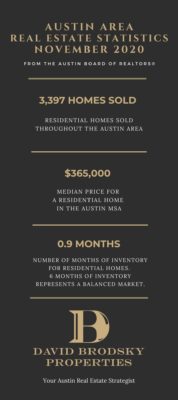 Houses for sale in Austin became even scarcer this November as buyers continue to flood the market despite the holidays and pandemic. The latest stats from the Austin Board of REALTORS® (ABoR) shows that home sales set a monthly record in November 2020. Median sales price made a big jump, too. One big decline in the regional home sales statistics is causing concern, though: housing inventory has dipped below one month for the first time ever. The Texas A&M Real Estate institute has established that 6.5 months of inventory is a balanced market.
Houses for sale in Austin became even scarcer this November as buyers continue to flood the market despite the holidays and pandemic. The latest stats from the Austin Board of REALTORS® (ABoR) shows that home sales set a monthly record in November 2020. Median sales price made a big jump, too. One big decline in the regional home sales statistics is causing concern, though: housing inventory has dipped below one month for the first time ever. The Texas A&M Real Estate institute has established that 6.5 months of inventory is a balanced market.
“Austin has been a top destination for those who want to live in a place where their money goes further than in other major cities like Los Angeles, New York, Chicago and Seattle,” said David Brodsky, broker/owner of the eponymous Austin real estate brokerage. The award-winning brokerage has a specialty in servicing relocation clients. This year, his brokerage has seen a spike in relocation business.
“The ongoing pandemic has forced people to reconsider where they live and why they live there. Since being close to an office isn’t a necessity like it was once was, workers have more freedom to choose where they live. A lot of newcomers have come to Central Texas this year since the region is more affordable than other popular cities and the lack of state income tax allows workers to get more for their hard-earned pay.”
Austin Real Estate Boom Fueled by Job Growth
Workers aren’t the only ones moving to Austin. This year, the Austin area has set a record for the number of new jobs created through corporate relocations. As of this November, there were 39 companies that had relocated to Austin in 2020. The number is growing, evidenced by the recent announcement that tech stalwart Oracle is relocating its headquarters from the Bay Area to Austin.
In fact, experts point to massive job growth as the reason Austin homes for sale are flying off the market. Mark Sprague, state director of information capital at Independence Title, pointed out the connection in ABoR’s report accompanying the November housing statistics.
“With a steady influx of job creation in the pipeline, the housing market will continue to post strong numbers well into 2021,” he said. “But, because Austin’s housing market is not slowing down, we will continue to see demand outpace the inventory available.” Greater demand and fewer Austin homes for sale mean increasing home values across the Central Texas region.
Outlook for Houses for Sale in Austin
 Sprague’s forecast is a strong message to would-be buyers that now is the time to act. Home prices and demand are expected to increase into the next year. Projected job growth data shows the likelihood that housing demand will continue to be strong well after that. Taking action to buy a home now will allow buyers to leverage current market dynamics and build wealth through home equity while demand is at its peak.
Sprague’s forecast is a strong message to would-be buyers that now is the time to act. Home prices and demand are expected to increase into the next year. Projected job growth data shows the likelihood that housing demand will continue to be strong well after that. Taking action to buy a home now will allow buyers to leverage current market dynamics and build wealth through home equity while demand is at its peak.
While median prices for houses for sale in Austin will continue to increase, the Austin real estate market is likely to moderate after making major gains through next year. The Central Texas region is uniquely positioned for long-term growth due to the amount of undeveloped and underdeveloped land surrounding the city center. There’s also infrastructure that’s currently underway that will enable Texans more flexibility in where they work and live, rather than forcing workers to stay within a reasonable commute to their place of employment. For these reasons, Central Texas real estate is still one of the safest investments for long-term equity growth.
City of Austin November 2020 Real Estate Statistics
- Median sales price rose 10.1% to $433,493
- Residential sales increased by 28.2% to 1,105 sales
- Sales dollar volume swelled 47.2% to $600,496,127
- New listings increased 9.9% to 897 listings
- Active listings decreased 28.2% to 1,064 listings
- Pending sales spiked 16.8% to 1,038 pending sales
- Monthly housing inventory decreased by 0.4 months to 1.0 months
Travis County
- Residential sales jumped 25.2% to 1,720 sales
- Sales dollar volume spiked 54.6% to $961,793,770
- The median price increased by 19.7% year-over-year to reach $425,000
- New listings increased 8.2% to 1,388 listings
- Active listings plummeted 47.2% to 1,523 listings
- Pending sales jumped 22.4% to 1,642 sales
- Monthly housing inventory dipped 0.9 months year-over-year to 0.9 months of inventory
Williamson County
- Residential sales increased by 19.8% to reach 1,127 home sales
- Sales dollar volume jumped 38.4% to reach $404,718,496
- Median sales price increased by 18% to reach $326,725
- New listings inched up by 2.2% to year-over-year to reach 903 listings
- Active listings dropped 71.8% to 604 listings
- Pending sales increased by 12.2% to 1,046 sales
- Housing inventory declined by 1.6 months year-over-year to reach 0.5 months of inventory
Hays County
- Residential sales increased by 30.4% to 403 sales
- Sales dollar volume spiked 54.6% to reach $170,600,406
- Median price increased by 18.5% to $303,525
- New listings increased by 6% to reach 338 listings
- Active listings dropped 50.7% to 439 listings
- Pending sales soared 54.6% year-over-year to reach 422 pending sales
- Housing inventory decreased by 1.6 months to 1.1 months of inventory
Bastrop County
- Residential sales increased by 14% year-over-year to reach 114 sales
- Sales dollar volume increased 17.4% to reach $31,303,538
- Median price increased by 6.4% to reach $260,950
- New listings made a 2.8% increase to reach 109 listings
- Active listings fell by 37.7% to 208 listings
- Pending sales jumped by 81.4% to 127 pending sales
- Housing inventory decreased by 1.7 months to reach 1.9 months of inventory
Caldwell County Real Estate Statistics
- Residential sales shot up 65% this November, reaching 33 sales
- Sales dollar volume increased year-over-year by 70.4% $6,961,699
- Median home price increased by 11.4% to reach $204,750
- New listings made a 14.3% gain to reach 24 listings
- Active listings dropped 32% to 68 listings
- Pending sales spiked 52.4% to reach 32 pending sales
- Housing inventory decreased 1.5 months to 2.5 months of inventory

